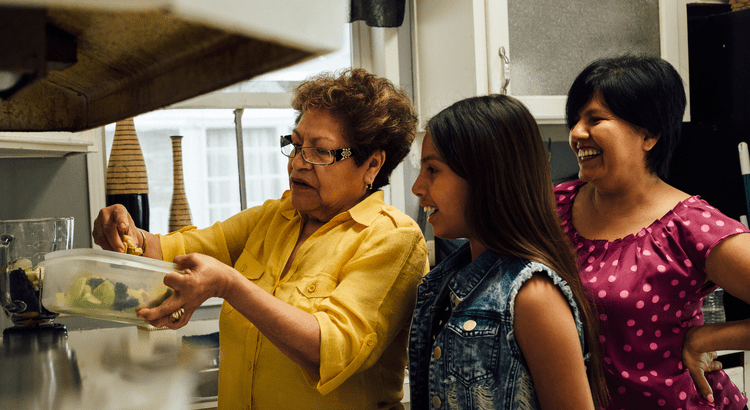Big Food Is Using AI To Create Healthier, Tastier Snacks And Meals. It Could Super-Charge Nutrition In America
Fortune Well October 8, 2023
Lifestyle

Fortune Well October 8, 2023
Lifestyle

Food manufacturers will soon be able to use AI and real-world patient data sets to nutritionally optimize their food—for diabetics, pre-diabetics, and the general population.
Nearly 40% of Americans have pre-diabetes, according to the U.S. Centers for Disease Control and Prevention—a condition in which blood glucose levels are elevated and can cause damage, but aren’t high enough to warrant an official diagnosis of diabetes. When it comes to diabetes itself, slightly more than a tenth of the U.S. population has the condition.
All told, roughly half of the U.S. population has one of the two.
“In general, we are just a very sick population of people,” Noosheen Hashemi, CEO of January AI, tells Fortune.
Her company markets a system that uses a continuous glucose monitor (CGM), an activity tracker like a smart watch or ring, and an AI-powered app. It can predict the blood glucose impact of more than 32 million foods on each user and suggest healthier alternatives—before they’re consumed.
January works by creating digital models of user physiology, using empirical evidence of how their glucose levels react to combinations of macronutrients—like fat, protein, and carbohydrates—to predict responses to different foods.
These “digital twins” of real people are anonymized and divided into three cohorts: diabetic, pre-diabetic, and non-diabetic. The company then takes recipes or foods from food companies and returns an analysis of the food’s impact on glucose levels in the cohorts, in a bid to help food companies create healthier products.
Among the company’s new partners: is Nestlé.
The technology “gives food companies an additional level of intelligence beyond what they already employ in their product development process,” Hashemi says. What’s more, it will allow them to create and refine products virtually, “before any costly lab work is undertaken,” she adds.
Food is the most impactful factor in glucose management. It plays “an outsized role in disease” in general, according to Hashemi, potentially influencing the development of obesity, heart disease, and even cancer.
The company’s consumer system could help detect diabetes and pre-diabetes earlier, Hashemi says. And it could help patients make lifestyle choices that may reverse the condition—and prevent the development of potentially devastating complications like blindness, amputation, heart attack, stroke, and kidney problems.
“Something like 30 million people took a genetic test,” she says, referring to U.S. purchases of direct-to-consumer genetic ancestry tests. “What if 30 million people tried a CGM one time?”
Many pre-diabetics and diabetics are unaware they have the condition and, thus, can’t intervene, meaning continuous damage to many major organs. Of the estimated 8.5 million Americans who have diabetes, 20% don’t know. And a whopping 90% of pre-diabetics are unaware of their condition.
While the American Diabetes Association recommends that all adults 45 and older, and younger people with major risk factors, are screened annually for the conditions, guidelines vary by medical organizations, and patients slip through the cracks.
The undiagnosed are “slowly marching toward potential disease without knowing it,” Hashemi says. “People are depending on the standard of care to protect them from disease, but they’re just finding out too late,” by the time complications have developed.
A CGM, Hashemi says, offers consumers the chance to take their health into their own hands—a process she calls “hacking your spiking food.”
“We thought people could inexpensively just find out if they’re one of those spikers,” she says, referring to people with diabetes or pre-diabetes whose blood glucose levels spike unusually high, to unhealthy levels, after eating.
“They could easily update their diet choices, like not putting an entire banana inside their smoothie.”
When the AI built into January AI’s consumer system spots trouble foods a user has eaten, it will recommend lower glycemic alternatives. It also prompts users to start and stop intermittent fasting and to exercise at times that are optimal for reducing blood glucose spikes.
But the system, with one two-week sensor, costs $288—a price inaccessible to many.
Extras like AI diet planning and customized exercise push alerts are ideal, but not necessary to spot concerning glucose trends and intervene oneself, with research and diet planning, Hashemi says.
She encourages those who haven’t been screened for diabetes or pre-diabetes recently and who can’t afford January AI’s system to ask their doctor for a prescription for an inexpensive CGM sensor. While insurance likely won’t cover the cost—around $80 for the cheapest on the market—the data provided by even one two-week sensor could be life-changing or even life-saving.
But not everyone can afford that, either. That’s why Hashemi is excited about partnering with major food manufacturers to make every-day meals healthier for everyone. That way, January AI’s technology can benefit a mass audience—even if only indirectly.
“We’re really excited about structural change to the food system—that, for us, is huge,” she says. “It could make everyone less sick, and that’s what we’re kind of obsessed with.”
Stay up to date on the latest real estate trends.

Buyer
July 1, 2025
Multi-generational living is on the rise.

Seller
June 30, 2025
Here’s something you need to know.

Buyer
June 29, 2025
We’ve officially reached the dog days of summer, and it’s not just you panting for relief.

Buyer
June 29, 2025
When choosing a fresh coat of paint for your space, picking the perfect color can feel like the most daunting task.

Buyer
June 29, 2025
If you're tired of seeing plain white walls and neutral interiors, then you'll be pleased to know that deeper jewel tones are trending again.

Lifestyle
June 28, 2025
Peppers add color, crunch, and a kick of flavor to everything from fajitas to fresh salads, but these heat‑lovers thrive when surrounded by the right garden friends.
We Guide Homeowners through the complicated process of selling their home using our 4 Phase Selling Process and 3 Prong Marketing Strategy that alleviates their stress and moves them effortlessly to their next destination. Schedule a 15 Minute Complimentary Strategy Session Today